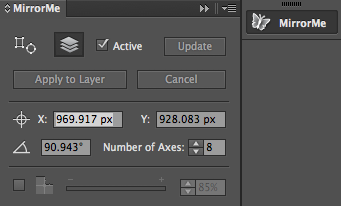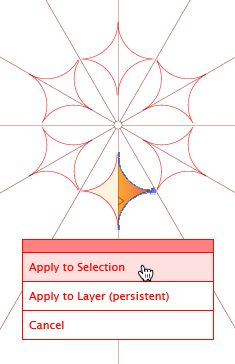Review: MirrorMe
Every so often a plug-in comes along that is both productive and just plain fun to use. MirrorMe, an inexpensive plug-in for Illustrator CS5–CC from Astute Graphics, is one of those plug-ins. As the name suggests, MirrorMe can reflect objects in Illustrator across axes, but it’s far more than a fancy version of Illustrator’s Reflect tool. If you think of a child’s kaleidoscope, you’re closer to understanding how much more MirrorMe can do quickly and easily.
Like most Astute Graphics plug-ins, MirrorMe comes with its own tool and a panel that can be docked in your workspace. The panel provides access to all the tool’s functions, as well as preferences to customize the tool’s behavior. When working with the tool, you’ll either select artwork, then use the tool to reflect it around a moveable point of origin on axes you customize, or you can use the tool to establish reflecting axes before you start drawing. MirrorMe creates normal paths that are editable with Illustrator’s tools, or with Astute Graphics own tools, such as InkScribe or DynamicSketch.

The expanded panel is docked with other panels in Illustrator, and displays most of the tool’s functions. The butterfly icon is used for the tool as well.
Reflecting Created Artwork
For an addictive and playful experience, create and select an object first, then grab the MirrorMe tool and hover over the object. Move the cursor without clicking to see a preview of your selection mirrored around at least one axis with the origin point for the reflection displayed directly beneath your cursor. Move your cursor over different areas on the artboard and the reflecting origin changes, changing what’s reflected. Use the right or left bracket keys on your keyboard to change the number of axes, and click once to place the reflecting origin. Next move the cursor somewhere off the origin and drag to change the angle of the reflecting axes. Drag on the origin or the axes, or keep using the bracket keys to alter the number of axes until you like what you see.

A shape (colored) made with Astute Graphics’ Dynamic Shapes plug-in, is reflected by changing the origin, number of axes, and angle of axes.
The next step is where the crazy fun really begins. Click once to stop the mirroring, then choose Apply to Selection in the Annotator (or panel). Hover again with the MirrorMe tool and it now starts mirroring the object you just created. You can repeat this entire process as long as you like, constantly coming up with new designs. When you no longer want to reflect the selected object, select another tool or choose Apply to Layer (Persistent) to retain the mirroring axes.

The original shape is reflected with a different origin, number of axes, and angle of axes two more times. The last time the result is applied to the layer, not the selection.

Upon applying the mirrored results to the layer, the axes are maintained and will reflect any other changes you make in the active segment.



I could definitely use this on a project I’m working on right now.
A neonatal NP is an advanced practice nurse who is trained to provide preventative and restorative healthcare to infants and neonates. Individuals that are interested in this field of nursing and who currently have a bachelor’s degree can enroll in a master’s program in nursing with a concentration in neonatal care nursing. A graduate of this program will be eligible to sit for the certification exam, which results in the certified neonatal NP designation.
What Does a Neonatal NP do?
The neonatal NP specialization will train RNs to care for neonates and infants in a neonatal care unit, including critically ill and preterm infants. The program curriculum will combine studies in nursing theories, healthcare promotion, field basics and research practices. The classwork will explore ways to assess the medical needs of neonates; treat and diagnose infants for disease and illness and administer and prescribe medications. The subjects discussed will include feeding patterns, immunizations, sleep cycles and health screenings. This program will also include conferences, seminars and a clinical rotation, which will require a student to work closely with neonates and infants at a local medical facility.
To qualify for enrollment, a student will need to have a bachelor’s degree from an accredited program and completion of prerequisite classes in statistics, developmental psychology, nutrition, microbiology and physiology. Other enrollment requirements will include high admission test scores and letters of reference from academic professionals. All applicants are required to hold a valid RN license, prior to working the clinical rotation portion of a program. family medicine np
A student will explore the theories of nursing practices and methods for providing quality medical attention to neonates and infants who are either in critical care or at risk. The classwork in this degree program will include such topics as neonatal pathophysiology, intensive care in nursing, neonatal healthcare assessments, pharmacology and nursing practice management.
Information on Certification for Neonatal NPs
Graduates from this program are eligible to sit for the certification exam, which is administered by the NCC and results in the NNP credential. A neonatal nurse practitioner is required to complete forty-five hours of continuing education every three years in order to maintain their certification. The graduate that’s interested in a career in teaching or research at the college level can enroll in a doctorate program in nursing. Doctorate programs will also feature specialty programs for the neonatal field.
According to statistics, the demand for this type of NP is expected to grow by more than twenty-two percent in the next five years, which is faster than the average healthcare job growth. Statistics provided by the BLS show the average salary for this position to range from $60,000 to $88,000, after three years working in the field.